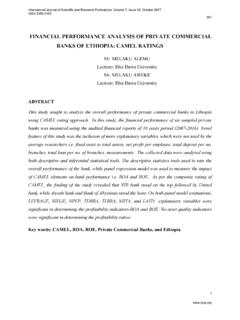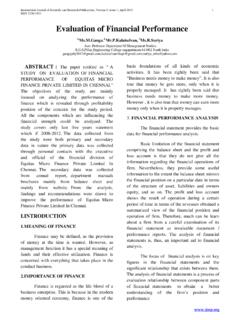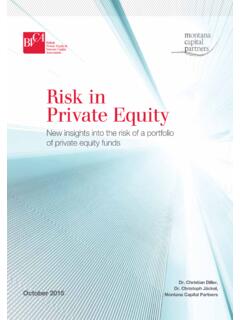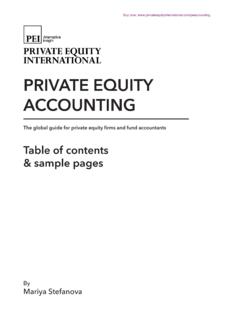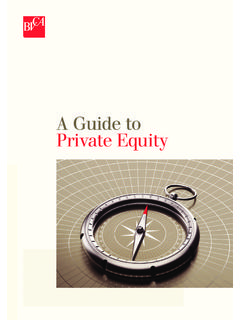Transcription of US Private Equity Index and Selected Benchmark Statistics
1 US Private Equity Index and Selected Benchmark Statistics March 31, 2018. Data as of US Private Equity Index and Selected Benchmark Statistics March 31, 2018. Note on Company Analysis Update Beginning in 2016, we have included company IRRs both by CA industry classifications and Global Industry Classification Standard ( GICS ). The Global Industry Classification Standard ( GICS ) was developed by and is the exclusive property and a service mark of MSCI, Inc. ( MSCI ) and S&P Global Market Intelligence LLC ( S&P ) and is licensed for use by Cambridge Associates. Pages with company IRRs by Global Industry Classification Standard ( GICS ) will be noted as such. Please note that no changes to the gross IRR calculations have been made. |2. Data as of US Private Equity Index and Selected Benchmark Statistics March 31, 2018. Disclaimer Our goal is to provide you with the most accurate and relevant performance information possible; as a result, Cambridge Associates'.
2 Research organization continually monitors the constantly evolving Private investments space and its fund managers. When we discern material changes in the structure of an asset class and/or a fund's investment strategy, it is in the interest of all users of our Benchmark Statistics that we implement the appropriate classification realignments. In addition, Cambridge Associates is always working to grow our Private investments performance database and ensure that our benchmarks are as representative as possible of investors' institutional-quality opportunity set. As a result we continually add funds to the database (both newly-raised funds and backfill funds) and occasionally we must remove funds that cease reporting. Our Private investments performance database is dynamic and will reflect both classification adjustments and changes to the underlying pool of contributing funds. As a result, you may notice quarter to quarter changes in the results of some historical Benchmark return analyses.
3 |3. Data as of US Private Equity Index and Selected Benchmark Statistics March 31, 2018. Overview Cambridge Associates' Private Investments Database is one of the most robust collections of institutional quality Private fund performance . It contains the historical performance records of over 2,000 fund managers and their over 7,300 funds. In addition, we capture the performance information (gross) of over 80,000 investments underlying our venture capital, growth Equity , buyout, subordinated capital and Private Equity energy funds. This is one of the largest collections of portfolio-level performance information in the world and represents the investments of approximately 77% of these funds on a count basis and 83% on a total commitment basis. This fund and investment-level performance information is drawn from the quarterly and audited annual financial statements of the fund managers and each manager's reported performance numbers are independently recreated from the financial statements and verified by Cambridge Associates.
4 Institutional Quality Data Cambridge Associates strives to include only institutional quality funds in our benchmarks. Institutional quality funds, in our definition, tend to meet the following criteria: closed-end funds, commingled funds that invest 3rd party capital (we exclude firms that invest off of their balance sheet, such as a bank's principal investing group or a corporate's venture capital arm), and fund vehicles. This institutional quality screen seeks to provide investors with performance data consistent with their investible opportunity set. Sources of Benchmark Data Our Benchmark database utilizes the quarterly unaudited and annual audited fund financial statements produced by the fund managers (GPs). for their Limited Partners (LPs). These documents are provided to Cambridge Associates by the fund managers themselves. Unlike other data providers, Cambridge Associates does not use Freedom of Information Act (FOIA) requests, regulatory filings, manager surveys, or press scrapings to obtain information.
5 Our goal is to have a complete historical record of the quarterly cash flows and net asset values for all funds in the benchmarks. We use a number of paths to encourage fund managers to submit their performance data to our database: our clients for whom we provide Private investment performance reporting, our research organization's regular meetings with thousands of managers, our special projects designed to enhance existing benchmarks or launch new ones, our exclusive relationships with over ten globally-diverse fund manager associations, and finally, our exclusive relationships with Thomson Reuters and the Institutional Limited Partners Association (ILPA). By leveraging these varied sources and proprietary relationships, Cambridge Associates has constructed a rich and diversified Benchmark data set. Vintage Year Definition Vintage year is defined as the legal inception date as noted in a fund's financial statement. This date can usually be found in the first note to the audited financial statements and is prior to the first close or capital call.
6 |4. Data as of US Private Equity Index and Selected Benchmark Statistics March 31, 2018. Timing of Final Benchmarks and Data Evolution The Cambridge Associates' benchmarks are reported on a one-quarter lag from the end of the performance quarter due to the reporting time frame of Private investments fund managers. Published Data: When the vast majority of a Benchmark group's (organized by asset class, Venture Capital or Real Estate). performance information is updated for a performance quarter, that Benchmark is considered final and the data is published via the quarterly Benchmark reports. Changes to Data: After a Benchmark group is published, any updates to historical data for these funds, which can include adding a fund and its performance history to the database ( backfills ) and/or updating past information for an existing fund due to late-arriving, updated, or refined information, would be reflected when that group is published for the next performance quarter.
7 In addition, Cambridge Associates may change the classification of certain funds; this often driven by the evolution of Private investments and the resulting need to introduce new benchmarks or refine our classification scheme. For example, as growth Equity emerged as an asset class we reclassified certain venture capital and buyout funds accordingly. Survivorship Bias: In order to track the performance of a fund in our benchmarks, we require the complete set of financial statements from the fund's inception to the most current reporting date. When an active fund stops providing financial statements, we reach out to the manager and make several attempts to encourage them to continue to submit their data. We may, during this communication period, roll forward the fund's last reported quarter's net asset value (NAV) for several quarters. When we are convinced that the manager will not resume reporting to us, the fund's entire performance history is removed from the database.
8 When fund managers stop reporting before their fund's return history is complete, an element of survivorship bias may be introduced to a performance database, which could skew the reported returns upwards if the funds dropping out had poorer returns than those funds that remained. Survivorship bias can affect all investment manager databases, including those for public stock managers and hedge funds. Compared to public stocks and hedge funds, however, the illiquid nature of Private investments can actually help limit this survivorship effect. Whereas an underperforming stock manager may simply close up shop or drop out of databases as clients liquidate their positions and fire the manager, Private investment partnerships owning illiquid assets continue to exist and require reporting to the limited partners, even if the original manager ceases to exist. Over the last nine years the number of fund managers that stopped reporting to Cambridge Associates before liquidation represented an average of (per year) of the total number of funds in the database during the respective year, and an average of (per year) as a percentage of total NAV in the database during that respective year.
9 During that same period the overall number of funds in our database increased by an average of 8% (per year). The performance of the small number of funds that have stopped reporting has been spread amongst all quartiles and has not been concentrated consistently in the poorer performing quartiles. |5. Data as of US Private Equity Index and Selected Benchmark Statistics March 31, 2018. Table of Contents US Private Equity Fund Index Analysis 7. mPME Returns Index Returns Fund Since Inception Analysis 12. mPME Returns Since Inception Returns Company Analysis 20. Methodology 25. |6. US Private Equity : Fund Index Analysis |7. Data as of US Private Equity Index and Selected Benchmark Statistics March 31, 2018. US Private Equity : Fund Index Summary: Horizon Pooled Return Net to Limited Partners Index 1-Quarter 1-Year 3-Year 5-Year 10-Year 15-Year 20-Year 25-Year Cambridge Associates LLC US Private Equity Index 1 Bloomberg Barclays Government/Credit Bond Index Dow Jones Industrial Average Index Dow Jones US Small Cap Index Dow Jones US TopCap Index Nasdaq Composite Index * Russell 1000 Index Russell 2000 Index S&P 500 Index Wilshire 5000 Total Market Index The Cambridge Associates LLC US Private Equity Index is a horizon calculation based on data compiled from 1,468 US Private Equity funds (buyout, growth Equity , Private Equity energy and subordinated capital funds), including fully liquidated partnerships, formed between 1986 and 2017.
10 1 Private indexes are pooled horizon internal rate of return (IRR) calculations, net of fees, expenses, and carried interest. The timing and magnitude of fund cash flows are integral to the IRR performance calculation. Public indexes are average annual compounded return (AACR) calculations which are time weighted measures over the specified time horizon, and are shown for reference and directional purposes only. Due to the fundamental differences between the two calculations, direct comparison of IRRs to AACRs is not recommended. For a more accurate means of comparing Private investment performance relative to public alternatives, see the analyses in this document using CA Modified Public Market Equivalent (mPME). See Methodology section for more detail. Sources: Cambridge Associates LLC, Bloomberg Barclays, Dow Jones Indexes, Frank Russell Company, Standard & Poor's, Thomson Reuters Datastream, and Wilshire Associates, Inc. *Capital change only.



